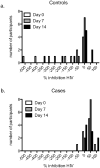Changes in the soluble mucosal immune environment during genital herpes outbreaks
- PMID: 22820806
- PMCID: PMC3685489
- DOI: 10.1097/QAI.0b013e31826867ae
Changes in the soluble mucosal immune environment during genital herpes outbreaks
Abstract
Background: Genital tract secretions provide variable inhibitory activity against herpes simplex virus (HSV) ex vivo. We hypothesize that the anti-HSV activity may prevent the spread of virus from the more commonly affected sites, such as the external genitalia, to the upper genital tract.
Methods: The antimicrobial activity of cervicovaginal lavage (CVL) and concentrations of mucosal immune mediators were measured in 10 HIV-seronegative women with an active external herpetic lesion and compared with 10 HIV-seronegative women who were HSV-1 and HSV-2 seronegative. Samples were obtained at the time of a symptomatic external lesion (day 0), after 1 week of oral acyclovir (day 7), and 1 week after completing treatment (day 14). Controls were evaluated at parallel intervals.
Results: The anti-HSV activity was higher in CVL obtained from cases compared to controls at presentation (day 0) (54.3% vs. 28%), fell to similar levels on day 7, and then rebounded on day 14 (69% vs. 25%). The anti-HSV activity correlated positively and significantly with the concentrations of several inflammatory proteins; the concentrations of these proteins tended to be higher in cases compared with controls and followed a similar temporal pattern.
Conclusions: Increases in inflammatory immune mediators and anti-HSV activity were detected in CVL at the time of clinical outbreaks and after completion of a short course of acyclovir. These mucosal responses may protect against HSV spread but could facilitate HIV infection and contribute to the clinical observation that, independent of clinical lesions, HSV-2 is a risk factor for HIV acquisition.
Figures


References
-
- Roberts C. Genital herpes in young adults: changing sexual behaviours, epidemiology and management. Herpes. 2005 Jun;12(1):10–14. - PubMed
-
- Roberts CM, Pfister JR, Spear SJ. Increasing proportion of herpes simplex virus type 1 as a cause of genital herpes infection in college students. Sex Transm Dis. 2003 Oct;30(10):797–800. - PubMed
-
- Xu F, Sternberg MR, Kottiri BJ, et al. Trends in herpes simplex virus type 1 and type 2 seroprevalence in the United States. JAMA. 2006 Aug 23;296(8):964–973. - PubMed
-
- Nagot N, Ouedraogo A, Foulongne V, et al. Reduction of HIV-1 RNA levels with therapy to suppress herpes simplex virus. N Engl J Med. 2007 Feb 22;356(8):790–799. - PubMed
Publication types
MeSH terms
Substances
Grants and funding
LinkOut - more resources
Full Text Sources
Medical

